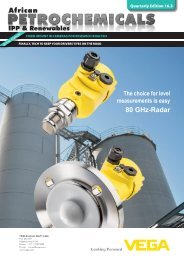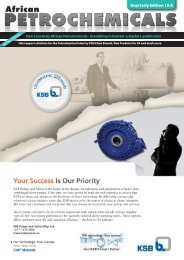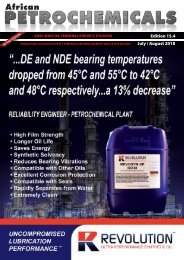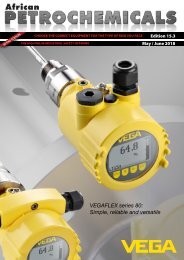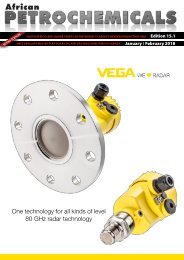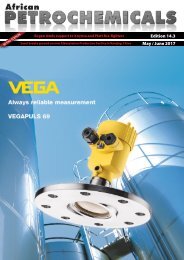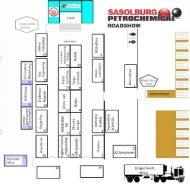African Petrochemicals Edition_16.2
You also want an ePaper? Increase the reach of your titles
YUMPU automatically turns print PDFs into web optimized ePapers that Google loves.
MINEARC EDITORIAL: CONVERTING SHELTER-IN-PLACE<br />
LOCATIONS TO ZERO VULNERABILITY SAFE HAVENS<br />
AirBANK Positive Pressure System with breathable air cylinders.<br />
4<br />
While it is not uncommon to find<br />
shelter-in-place or safe haven locations<br />
designated across chemical facilities,<br />
what varies is the level of protection<br />
offered at these sites. Functionality<br />
can range from merely a muster point<br />
(shelter-in-place) to a positively<br />
pressurized room (safe haven). Either<br />
way, when determining if a room is<br />
acceptable for the job, the industry<br />
generally applies a vulnerability factor;<br />
in other words, the probability of a<br />
fatality being less than one percent.<br />
Emergency shelter-in-place (SIP) should<br />
form an integral part of any chemical<br />
plant’s broader emergency response plan.<br />
Explosions, fires, and the release of smoke<br />
or other toxic gases are some of the types of<br />
incidents that can occur despite high levels<br />
of planning and safety precautions.<br />
Numerous government agencies and other<br />
organisations recommend SIP to protect<br />
personnel from harm in the event of a<br />
chemical release. Any building may be used<br />
as a temporary measure to reduce health<br />
risk from exposure to the toxic materials<br />
by simply closing windows and doors<br />
and turning off ventilation fans and air<br />
conditioning/heating systems.<br />
Three factors govern the effectiveness of a<br />
SIP location:<br />
• the tightness of the building or leakage<br />
rate<br />
• the concentration of the toxic gas, and<br />
• the release duration.<br />
The tightness of the building is primarily<br />
based on building construction; however,<br />
temperature differential and wind speed can<br />
also play a factor.<br />
Identification of the maximum toxic<br />
concentration occurs during a Facility Siting<br />
Study (FSS). FSS’s are a hazard analysis<br />
that defines Maximum Credible Event<br />
(MCE) scenarios using a consequencebased<br />
approach to produce a quantitative<br />
risk assessment. Determining potential<br />
consequences is a necessary step in the<br />
process of developing a comprehensive<br />
safety plan.<br />
The FSS also determines the expected release<br />
duration based on stored inventories of toxic<br />
materials. The higher the toxic concentration<br />
and longer the release duration, the less<br />
effective sheltering-in-place becomes.<br />
While occupants may feel safe sheltering-inplace<br />
from the external toxic hazard, typical<br />
buildings have high leakage rates. A typical<br />
wood framed constructed building can<br />
have 3-5 air changes per hour, rendering it<br />
ineffective against most chemical releases.<br />
Additionally, sealing to an acceptable<br />
airtightness can be time consuming and<br />
expensive and even with professional air<br />
sealing it is very difficult to seal existing<br />
structures to an acceptable tightness.<br />
There are considerations for effectively<br />
sealing existing infrastructure and ensuring<br />
positive pressure to ensure contaminants<br />
do not infiltrate safe haven locations along.<br />
Critical elements of life support that are<br />
of primary importance to human survival<br />
must also be considering when converting a<br />
shelter to a safe haven; including:<br />
• Positive pressure<br />
• Breathable air supply<br />
• Supplemental oxygen<br />
• Removal of accumulated carbon dioxide<br />
• Cooling and dehumidifying<br />
MineARC Systems have converted SIP spaces<br />
to positive pressure safe havens with the<br />
installation of life support systems across<br />
many chemical sites globally. The MineARC<br />
AirBANK Positive Pressure System provides<br />
rapid pressurization, which is activated<br />
and maintained using the AirBANK Control<br />
via a simple human-machine interface<br />
(HMI) touch screen. MineARC’s integrated<br />
Aura-FX Gas Monitor ensures breathable air<br />
automatically remains within acceptable<br />
limits. Additionally, supplementary oxygen<br />
and carbon dioxide scrubbing systems can<br />
be installed as required.<br />
Reducing the risk of harm to personnel is a<br />
priority for emergency response planning.<br />
While the likelihood of an Maximum Credible<br />
Event occurring may be low, the risk to onsite<br />
personnel in the event of an incident<br />
is high. Converting shelter-in-place (SIP)<br />
locations to zero vulnerability safe havens<br />
improves emergency response.<br />
For more information about the conversion<br />
of a shelter-in-place to a safe haven on<br />
your site, please contact a local MineARC<br />
representative at info@minearc.co.za.




